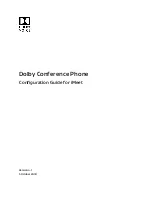
ScoopTeam - User manual - Draft 0002
17
2.5. User interface and control
The control and supervision of the equipment (configuration, communication management, status
monitoring), is carried out in two general ways: “local” user interface using the physical display and
input devices, or “remote” control.
2.5.1. User interface
The user interface elements are as follows:
Color 7” TFT display with touch screen
One rotary encoder to adjust settings
Monitoring shortcut key and Communication shortcut key
Dedicated backlit keys for each commentator position: Program key, Coord key
Dedicated potentiometers for volume control for each commentator position: general
headphone volume, side tone volume
For commentator positions 1 and 2, assignable potentiometers, 4 for each position. These
knobs can be configured for directly controlling the gain of selected sources in the monitoring
mix.
7 assignable backlit function keys. These keys can be assigned various functions, as detailed
further in 2.5.6, Assignable function keys.
The operation is described further in the following chapters.
2.5.2. Remote control
Basically all the parameters of the unit can be remote controlled via IP, using the unit’s control protocol.
Two control tools are available for operating the unit by remote.
A dedicated application (
NYA
) provides complete control over the unit from a computer
(Windows, iOS, Android). See in chapter xxx the detailed operating mode.
An embedded html server provides html pages that enable partial control using a web browser,
via port 80 (default port for the HTTP protocol). This control mode can be used from any
computer regardless of its OS (or a mobile device with a web browser), and the embedded
pages are compatible with all current browsers. No software installation is needed on the
control device. However, this tool has a limited range of features and is not suitable for normal
operation.
2.5.3. Remote control interfaces
The unit provides several ways (
NYA
) to remote control the unit via IP:
The main Ethernet interface, used for audio streaming, can be used for remote control as well.
The auxiliary Ethernet interface (10/100BaseT) is the normal default interface for remote
control.
The data connection over the mobile network can be used for remote control.
Connection via Wi-Fi (see above in 2.3.4, Wi-Fi interface (
The interface that is used is selected by the user from the unit’s menu.
















































